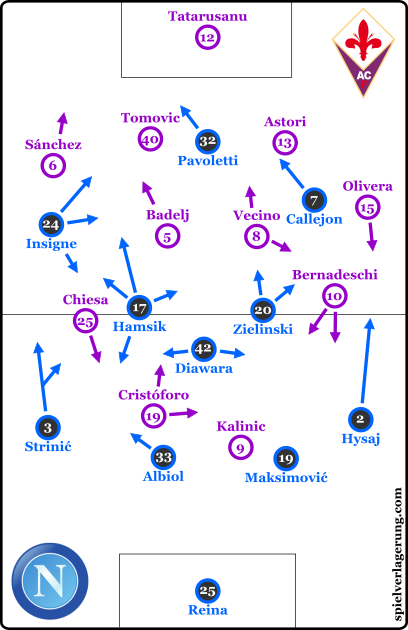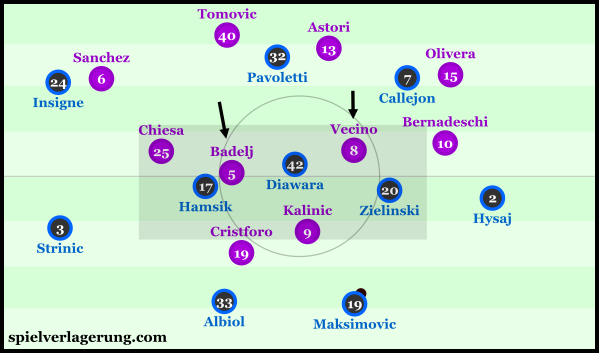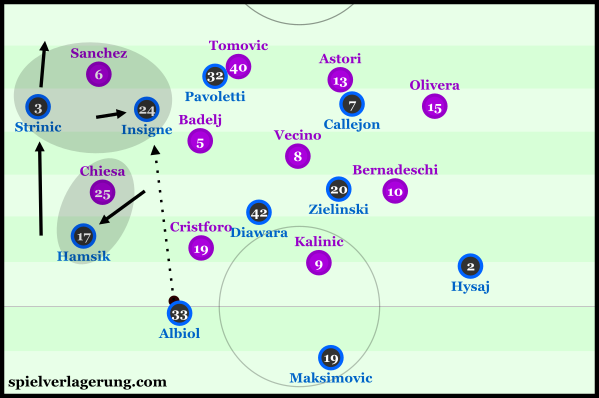Napoli beat Fiorentina with Threatening Left-Sided Dynamics
Napoli reach the semi-final of the Coppa Italia after overcoming Fiorentina. It was a typical performance of the hosts, whose left side was prominent. They shaped-up in their typical 4-3-3 against a less-orthodox 4-4-1-1 from Fiorentina, which featured a lop-sided first line during build-up.
 Napoli Threaten Through the Left Side
Napoli Threaten Through the Left Side
Napoli were superior for the majority of the game, and a main source of their success came from their left side. Build-up commonly progressed through Strinic, who was access immediately from Albiol, or as part of a longer switch across the back-line. With Fiorentina’s approach restricting the space of Napoli’s midfield three, it was often the left-back who was the man with space during early Napoli possession.
In some cases, in fact, it seemed to be the intention of Marek Hamsik to occupy Fiorentina’s midfield so to provide his wider teammate with more space. The Slovakian could often be seen in a slightly inside position, or making runs into depth closer to the touchline in order to take Chiesa away. Such a detail was important in Napoli building cleanly through the wide area, as Strinic had sufficient time to balance some of the strategic disadvantages of the left side.
- With Hamsik in the left half-space, Chiesa’s defensive positioning was slightly narrower in reaction, giving him greater distance to Strinic and the worry of Hamsik in his cover shadow, complicating his pressing action.
- If Hamsik was running into depth, it forced Chiesa into a deeper position and similarly gave the left-back more time on the ball, so he could carry the ball forward, search for passes, give suitable time for him and his teammates to create connections and at times, allow him to move slightly inside to have a more central position to pass from.
Of course, Strinic was not the only beneficiary of these movements, which were closely linked to the activity of Napoli’s talisman Lorenzo Insigne. The Italian was marked closely by Sánchez, and thus had to come up with solutions to allow himself to fully participate in Napoli’s attack. To do so, he often drifted a considerable distance into the half-space in order to discourage the Fiorentina full-back from following him. In these moments, Hamsik’s movement in wide areas could almost ensure that Insigne would receive the ball uncovered. If Hamsik dropped deep, then he could stretch the connection between Chiesa and Badelj, giving a small corridor for Insigne to receive in while Strinic attacked Sánchez with one of his typical direct runs.
Napoli’s excellent combinative talents was also an important enabler of their play down the left side. All three of Strinic, Hamsik and especially Insigne are technically strong, and they showed this in their fast combinations down the touchline. Through their speed of play, in a number of cases they overcame Fiorentina’s man-oriented defense simply by being faster than them in both their movements and passing. This was particularly the case between minutes 25 to 40, which was a particular spell of Napolese dominance. The third-man runs of Strinic and Hamsik became more aggressive, and their combinations became more cleaner (which was undoubtedly effected by the movements) and they found a number of openings behind Fiorentina’s right-back.
Passive Fiorentina Defence
Napoli themselves carried out their left-sided plays fairly well, but their job was made easier by a passive Fiorentina defence. The focus seemed to be on suffocating the space around Diawara and the two eights, which resulted in the flanks often being open. Of course, this would be completely stable, if the visitors shifted over in reaction to passes towards Strinic, and constricted the space against the touchline. It would allow them to minimise Napoli’s space, reduce the threat of their potent left side and potentially even force turnovers, yet no such reaction was to be seen.

Fiorentina covered Napoli’s midfield space fairly well, but failed to adjust when the ball was played to Strinic.
Instead, Chiesa’s movement was far too lax, and Strinic sometimes had 4-5 seconds of time before a challenge was even close. Of course, the aforementioned movements and structure of Napoli was designed to make access difficult in these moments, but it certainly wasn’t an impossible for the visitors. A more ball-oriented block, and simply greater intensity in the shifting and pressing actions would’ve made it much more difficult for Napoli to form half of the attacks they made down this side. Fiorentina’s passivity is even more perplexing, when you consider the excellent talents that Sarri’s side possess down this side of the team.
Fiorentina’s Build-up Issues
In contrast to their hosts, Fiorentina struggled to form any good quality shots from sustained possession. Problems were evident from build-up, as they failed to consistently progress the ball in a clean manner. An interesting feature of this moment, was their four-man defensive line displaying some asymmetry, which shifted into a chain of three in the first line of players. Sánchez, the right-back, stayed deep within the structure while Olivera, on the left, was positioned in a much more orthodox manner.
I’m not entirely sure of the purpose behind this, but it could have been as a protective measure against the threat of Napoli and Insigne in transition. Additionally, it allowed both Vecino and Badelj to stay in the midfield line and thus increase their presence in the centre. Regardless, this shape gave Fiorentina a tendency to build through their right side, with Sánchez more available against pressure than Olivera on the opposite flank. Yet this feature of their build-up created more issues and solutions against Napoli’s pressure.
Upon receiving the ball in build-up, Sánchez was commonly disconnected from his teammates. Chiesa was often too high up the field, and even if he did receive the ball, his position close to the touchline and body position meant that Strinic could easily pressure from behind and nip any progressions in the bud. Badelj was the only reasonable forwards option, but this diagonal connection into the centre was generally only open on the half-dozen or so occasions when Napoli’s press lacked access, with Hamsik positioned too deep and far away from his man.
Short-Lived Improvements
It came as a surprise, then, that Fiorentina began the second half as the better side. The first ten minutes were particularly promising for Paulo Sousa, whose team’s structure was more connected in deeper areas and thus benefited from a healthier circulation of the ball. The movements were more harmonious and particularly between the wide triangles of centre-back, full-back and central midfielder. Bernadeschi and Chiesa were operating in narrower positions, which gave a more central route into the attack as opposed to the wider attempts in the first half, which Napoli easily cut off. They had greater freedom from Napoli’s pressure, which lacked the intensity that it ended the first half with, which seemed a mixture of both Napoli’s passivity, and Fiorentina’s improved structure and dynamics making access more difficult to achieve.
This promise was short-lived, however, as the momentum shifted back into Napoli’s favour around the 60th minute. There didn’t seem to be any real changes which caused the change, but Napoli’s intensity was regained and they themselves had more effective possession than they showed in the opening ten. The match continued largely as the first half had done, with a focus down Napoli’s left side, but they were doing so slightly more directly as the second half progressed. Longer through-balls were being played over the shorter and more complex combinations we saw in the first half, which could’ve been in an attempt to create more isolations for Insigne, as well as Hamsik at times.
Not only did one of these longer passes result in Insigne doing that to Sánchez but it also, and slightly more importantly, brought about the only goal of the game. Following a long pass from Reina, Diawara played diagonally to Insigne to the wing, and just as he had threatened all game, Hamsik made a third-man run to continue the attack before crossing to Callejon, who finally connected with a whipped cross. Such a pattern was hardly surprising, and was an attack which Napoli had carried-out numerous times already in the 70 minutes played.
Conclusion
Despite this one goal being the difference, Napoli were by far the better team for most of the game. Their dominance was sourced from their left side, which was a near-constant threat before it finally resulted in the deciding goal after a more direct approach was adopted.



4 Kommentare Alle anzeigen
The Kaiser February 7, 2017 um 4:50 pm
@TP
Do you think Napoli´s combination game you pose a threat for real madrid in the upcoming round of 16?
Flavio January 26, 2017 um 8:29 am
Fiorentina always create a back three in their build up with that movement. Usually sees them attack in 3-4-2-1 before defending in 4-4-1-1 where the left wing-back drops in to make up the back four and the left attacking midfielder in the “2” becomes the left midfielder. Possibly didn’t work as well in this match as normal, but they consistently use that movement to create triangles and diamonds across the pitch.
Jorge January 25, 2017 um 8:26 pm
Some of the problems that Fiorentina faced in the build-up phase might be related to the clever pressure from Napoli, wich Sarri allways slightly adjusts to the opponent and prevented Fiorentina having a clean first pass. A portuguese blogger made a video on this
http://dominiotactico.blogspot.pt/2017/01/napoles-organizacao-da-pressao.html
Sarri’s Napoli truly is one of the best teams in the world, despite not having the same individual quality of others, watching their matches i allways enjoyable.
August Bebel January 29, 2017 um 1:59 am
I love to see them play, too. I was wondering, however, what they’ll do if the opponent tries to direct them to their right side, because they always are (at least as far as I know) very left-sided.